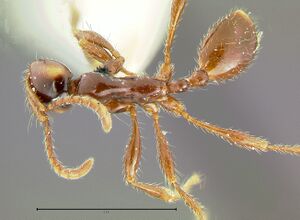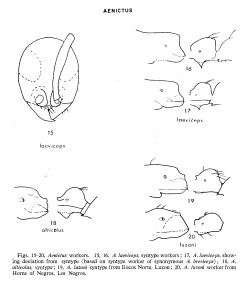Aenictus luzoni
| Aenictus luzoni | |
|---|---|

| |
| Scientific classification | |
| Kingdom: | Animalia |
| Phylum: | Arthropoda |
| Class: | Insecta |
| Order: | Hymenoptera |
| Family: | Formicidae |
| Subfamily: | Dorylinae |
| Genus: | Aenictus |
| Species: | A. luzoni |
| Binomial name | |
| Aenictus luzoni Wheeler, W.M. & Chapman, 1925 | |
Nothing is known about the biology of Aenictus luzoni.
Identification
A member of the laeviceps species group. A. luzoni is most similar to Aenictus alticola in having the subpetiolar process low and anteriorly angulate. (Jaitrong and Yamane 2011)
Keys including this Species
Distribution
Known from Luzon and Negros, Philippines.
Latitudinal Distribution Pattern
Latitudinal Range: 18.5376° to 5.975°.
| North Temperate |
North Subtropical |
Tropical | South Subtropical |
South Temperate |
- Source: AntMaps
Distribution based on Regional Taxon Lists
Indo-Australian Region: Philippines (type locality).
Distribution based on AntMaps
Distribution based on AntWeb specimens
Check data from AntWeb
Countries Occupied
| Number of countries occupied by this species based on AntWiki Regional Taxon Lists. In general, fewer countries occupied indicates a narrower range, while more countries indicates a more widespread species. |

|
Estimated Abundance
| Relative abundance based on number of AntMaps records per species (this species within the purple bar). Fewer records (to the left) indicates a less abundant/encountered species while more records (to the right) indicates more abundant/encountered species. |

|
Biology
Castes
Known only from the worker caste.
   
| |
| . | Owned by Museum of Comparative Zoology. |
Nomenclature
The following information is derived from Barry Bolton's Online Catalogue of the Ants of the World.
- luzoni. Aenictus luzoni Wheeler, W.M. & Chapman, 1925: 48, pl. 1, figs. 1, 2 (w.) PHILIPPINES (Luzon).
- Type-material: lectotype worker (by designation of Jaitrong & Yamane, 2011: 40), 1 paralectotype worker.
- [Note: original description cites 8w syntypes.]
- Type-locality: lectotype Philippines: Luzon, Ilocos Norte Prov., Bangui (C.S. Banks); paralectotype with same data.
- Type-depository: MCZC.
- Combination in A. (Typhlatta): Wheeler, W.M. 1930g: 199.
- [Misspelled as luzonensis by Chapman & Capco, 1951: 13.]
- Status as species: Wheeler, W.M. 1930g: 206; Chapman & Capco, 1951: 13; Chapman, 1963: 263; Wilson, 1964a: 470; Baltazar, 1966: 231; Bolton, 1995b: 60; Jaitrong & Yamane, 2011: 40 (redescription).
- Distribution: Philippines (Luzon, Negros).
Unless otherwise noted the text for the remainder of this section is reported from the publication that includes the original description.
Description
Worker
Jaitrong and Yamane (2011) - Measurements. Worker lectotype and paralectotype (n = 2): TL 3.95– 4.00 mm; HL 0.85–0.88 mm; HW 0.78 mm; SL 0.73–0.75 mm; ML 1.38–1.43 mm; PL 0.33 mm; CI 89–91; SI 94–97.
Lectotype and paralectotype - Head in full-face view slightly longer than broad, with sides and posterior margin feebly convex; occipital margin bearing a carina. Antennal scape relatively short and thin, not reaching the posterolateral corner of head; antennal segments II–X each longer than broad; II slightly longer than each of III–VII. Frontal carina short, slightly extending beyond the posterior margin of torulus.
Anterior margin of clypeus convex, bearing several denticles. Masticatory margin of mandible with a large apical tooth followed by a medium-sized subapical tooth, 4 denticles, and a medium-sized basal tooth; basal margin lacking denticles. Mesosoma relatively slender; promesonotum in profile convex dorsally and sloping gradually to metanotal groove; dorsal outline of propodeum almost straight; area between propodeal spiracle and metanotal gland bulla impressed; propodeal junction rounded; declivity feebly concave, not margined dorsally and laterally. Petiole relatively short, almost as long as high; its node in dorsal outline strongly convex; subpetiolar process weakly developed, triangular, apex directed downward and forward; postpetiole almost as long as petiole. Entire head including antennal scape smooth and shiny. Mandible very finely striate except along masticatory margin. Mesosoma entirely smooth and shiny, except for metapleuron and metanotal groove that have irregular longitudinal rugae; propodeal dorsum with about 3–5 short longitudinal rugae. Petiole and postpetiole entirely smooth and shiny. Legs entirely smooth and shiny.
Head and mesosoma dorsally with relatively sparse standing hairs mixed with sparse short hairs over the surface; longest pronotal hair 0.20 mm long. Entire body reddish-brown. Typhlatta spot located anterior to occipital corner.
Type Material
Jaitrong and Yamane (2011) - Two syntype workers from Philippines, Luzon, Ilocos Norte Prov., Bangui (Museum of Comparative Zoology, examined). One worker is selected as the lectotype, the other as paralectotype.
References
- Chapman, J. W.; Capco, S. R. 1951. Check list of the ants (Hymenoptera: Formicidae) of Asia. Monogr. Inst. Sci. Technol. Manila 1: 1-327 (page 13, checklist)
- Jaitrong, W. & Yamane, S. 2011. Synopsis of Aenictus species groups and revision of the A. currax and A. laeviceps groups in the eastern Oriental, Indo-Australian, and Australasian regions (Hymenoptera: Formicidae: Aenictinae). Zootaxa, 3128, 1–46. PDF
- Wheeler, W. M.; Chapman, J. W. 1925. The ants of the Philippine Islands. Part I, Dorylinae and Ponerinae. Philippine Journal of Science. 28: 47-73 (page 48, pl. 1, figs. 1, 2 worker described)
- Wilson, E. O. 1964a. The true army ants of the Indo-Australian area (Hymenoptera: Formicidae: Dorylinae). Pacific Insects. 6: 427-483 (page 470, see also)
References based on Global Ant Biodiversity Informatics
- Borowiec M. L. 2016. Generic revision of the ant subfamily Dorylinae (Hymenoptera, Formicidae). ZooKeys 608: 1–280.
- CSIRO Collection
- Chapman J. W. 1963. Some new and interesting Philippine ants (Hymenoptera: Formicidae). Philipp. J. Sci. 92: 247-263.
- Jaitrong W.; Yamane, S. 2011. Synopsis of Aenictus species groups and revision of the A. currax and A. laeviceps groups in the eastern Oriental, Indo-Australian, and Australasian regions (Hymenoptera: Formicidae: Aenictinae). Zootaxa 3128:1-46.
- Wheeler W. M. 1930. Philippine ants of the genus Aenictus with descriptions of the females of two species. Journal of the New York Entomological Society 38: 193-212.
- Wheeler W. M., and J. W. Chapman. 1925. The ants of the Philippine Islands. Part I, Dorylinae and Ponerinae. Philipp. J. Sci. 28: 47-73.
- Wilson E. O. 1964. The true army ants of the Indo-Australian area (Hymenoptera: Formicidae: Dorylinae). Pacific Insects 6: 427-483.


